Treasury has published annual estimates of Australian net private sector wealth since the Summer 1990 Economic Roundup. This article updates previous estimates and provides preliminary estimates for net private sector wealth as at June 2004.
The market value of Australian net private sector wealth grew by 17.6percent in the year to 30June2004. In real terms (that is, after allowing for inflation), wealth grew by 16.2percent. Real wealth per Australian grew by 14.9percent.
Wealth definitions and uses
From an economic perspective, wealth can be defined as ‘a store of spending power that can be carried into the future’ (Jones and Perkins 1986, p.150). Therefore, wealth includes a wide variety of assets, both financial assets, such as cash, shares and bonds, and non-financial assets, such as dwellings, factories and other business assets that can be used to generate future income.
Measurements of the store (or ‘stock’) of spending power, such as wealth, complement measurements of the production (or ‘flow’) of income, such as gross domestic product (GDP). Wealth thus provides a useful additional measure of living standards as well as a benchmark for examining trends in such aggregates as external liabilities and private sector debt. In addition, wealth appears to be a significant determinant of current and future aggregate private consumption.
Wealth can also include a variety of other less tangible assets that are sometimes referred to as ‘human wealth’. Human wealth includes, for example, the skills, education and social structures that contribute to an individual’s capacity to generate income in the future. In addition, a broader definition of wealth might include such assets as natural resources or aesthetic qualities.
The change in real net wealth of households from one period to the next is the pure economic definition of saving.1 Therefore, the annual change in real private sector wealth can be interpreted as the annual economic saving of the private sector.
Measuring wealth
From a practical perspective, some components of wealth can be extremely difficult to quantify. In particular, it is difficult to value those assets that are not readily tradeable and hence for which there are no readily observable prices. This is often the case for the various components of human wealth and some natural resources. As a result, the estimates in this article relate only to financial assets and non-financial (or physical) assets in those cases where there are well-developed markets and observable prices.
The scope of the estimates presented in this article is the Australian private sector. This consolidation of the private household and business sectors greatly simplifies the calculation of private sector wealth.2 However, thisconsolidation does result in a loss of detail on the liabilities of these two sectors. Consequently, the data on asset types contained in the attached tables and charts should not be used to infer relative ownership by either the household or business sectors, or the level of personal wealth.3
A number of assumptions and approximations are required to construct these estimates, particularly for the latest year where many of the data remain provisional. Together with inevitable revisions to historical data, these limitations imply that the estimates should be interpreted as indicative of trends and broad orders of magnitude, rather than precise estimates.
The Australian Bureau of Statistics (ABS) also publishes estimates of wealth. The appendix has a discussion of the relationship between these estimates and the Treasury estimates.
Methodology — How is wealth measured?
The wealth estimates presented in this article are a measure of the net value of domestic and foreign assets owned by the Australian private sector. These estimates are constructed using the inventory approach4, largely following the methodology of Callen(1991). This approach involves aggregating across different asset types and adjusting for the public and/or foreign ownership5 of assets. Theestimates are largely based on ABS estimates of the dwelling stock, business capital stock6, stock of consumer durables and Australia’s international investment position. Reserve Bank of Australia(RBA) data are used for holdings of public securities and RBA liabilities. Some private sector data and estimates from previous studies also enter the estimates.
Treasury estimates of net private sector wealth are calculated on both a market value and replacement cost basis. The market value of an asset represents the value that would be obtained if assets were to be sold in current market conditions. For example, dwelling wealth will move with house prices while business wealth will move with stock market prices. In contrast, the replacement cost of an asset is the cost of reproducing thatasset. That is, it is the price which would have to be paid for an identical asset which is in the same condition and expected to yield the same flow of services as the original asset. It is the relevant concept for physical assets such as consumer durables, the stock of dwellings and the business capital stock. The equivalent concept for financial assets is the face value, which in the case of debt, for example, represents the price (excluding any accrued interest or dividends) which the borrower promises to repay the lender on expiry of the loan.
Detailed wealth estimates since 1960 are presented in the attached tables.
Movements in Australian private sector wealth in 2004
Through the year to 30 June 2004, Australian net private sector wealth at market value grew by 17.6percent in nominal terms, 16.2 percent in real terms and 14.9percent in real percapita terms. The growth rate in nominal net private sector wealth during the year to June 2004 was the highest for more than a decade (Chart1). The tables in the appendix provide further details.
Chart 1: Growth in Australian net private sector wealth
at market value
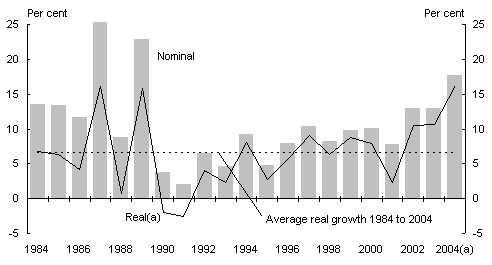
(a) Real wealth is determined using the consumption deflator. This includes the transitional impacts
of The New Tax System.
Source: Australian Government Treasury
In current prices, Australian net private sector wealth was approximately $5,145billion at market value as at 30 June 2004. This is the first time Australian net private wealth has climbed over $5trillion, and represents around $250,000 per Australian and 6.6times the value of the annual nominal gross domestic product of the economy. Real net wealth per Australian has increased for 13 consecutive years and has risen by over $51,300 in the past three years alone.
In the year to June 2004, growth in the market value of dwelling assets contributed 11.2percentage points to the growth in private wealth (see Chart 2). The strong growth in dwelling wealth is a direct result of the sharp rise in house prices throughout the country leading up to 2004. The ABS House price index reported a broad-based rise in established house prices of 12.6percent in the year to June 2004.
The other main influence on wealth over the period was business assets (net of Australian investment abroad and foreign liabilities), which contributed 7.8percentage points, more than double the long-term average contribution to growth of 3.1percentage points. This
follows a small subtraction in 2003. The rise in business assets coincided with large increases in the value of the stock market. The ASX 200 has continued to climb since its recent trough in February 2003, rising by 22.8percent over the year to December 2004. Movements in non-rural business assets, which make up over 80percent of total business assets, reflect changes in stock market prices and are, therefore, quite volatile.7
Chart 2: Contributions to growth in nominal Australian
net private sector wealth at market value(a)
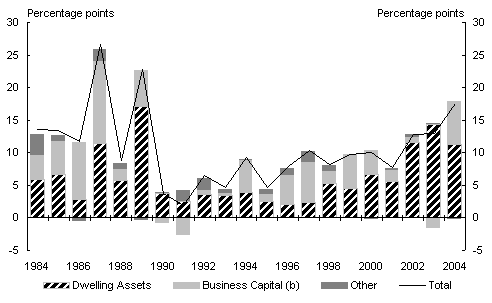
- Over the year to June 30.
- Includes Australian investment abroad and excludes foreign liabilities.
Source: Australian Government Treasury.
Composition of Australian net private wealth by asset type
The composition of wealth at market value by asset type slightly shifted back to historical averages during the year to 30June2004 (Chart 3). Dwelling assets comprised a smaller proportion of Australian net private sector wealth (down 2percent compared with 2003) while the share of business assets rose (up 2percent). Further compositional changes are expected if the current moderation in house price growth continues.
Chart 3: Composition of Australian net private sector wealth
by asset type
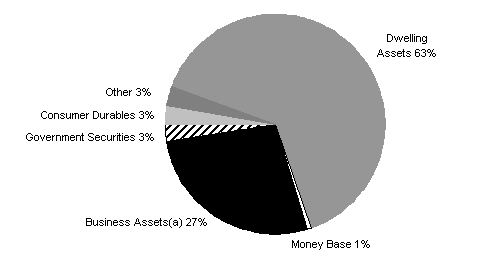
- Includes Australian investment abroad and excludes foreign liabilities.
Source: Australian Government Treasury.
References
Australian Bureau of Statistics, 2003-2004, Australian System of National Accounts, cat.no.5204.0, ABS, Canberra.
Australian Bureau of Statistics, September Quarter 2004, Australian National Accounts: National Income, Expenditure and Product, cat. no. 5206.0, ABS, Canberra.
Australian Bureau of Statistics, September Quarter 2004, Australian National Accounts: Financial Accounts, cat.no. 5232.0, ABS, Canberra.
Australian Bureau of Statistics, 1999-2000, Australian National Accounts: National Balance Sheet, cat. no. 5241.0.40.001, ABS, Canberra.
Bacon, BR 1998, Household Wealth and the Aged: An Income Distribution Survey Analysis, Sixth Colloquium of Superannuation Researchers, University of Melbourne, July 1998, Conference Paper No. 3.
Callen, T 1991, ‘Estimates of Private Sector Wealth’, Reserve Bank of Australia, Research Discussion Paper 9109.
Department of the Treasury 1990, ‘Private Sector Wealth Estimates in Australia’ Economic Roundup, Summer 1990, Australian Government Publishing Service, Canberra.
Department of the Treasury 1996, ‘Documentation of the Treasury Macroeconomic(TRYM) Model of the Australian Economy’, Treasury, Canberra.
Department of the Treasury 1999, ‘The Measurement of Saving in Australia’ Economic Roundup, Spring 1999, Australian Government Publishing Service, Canberra.
Ellis, L & Andrews, D 2001, ‘City Sizes, Housing Costs, and Wealth’, Reserve Bank of Australia, Research Discussion Paper 2001-08.
International Monetary Fund 2002, World Economic Outlook, April.
Jones, RS and Perkins, JON 1986, Contemporary Macroeconomics, 2nd edn, Prentice-Hall, Sydney.
OECD Economic Outlook, 2002/03, No. 72 December.
Piggott, J 1987, ‘The Nation’s Private Wealth — Some New Calculations for Australia’, The Economic Record, March.
Appendix
Relationship with the ABS national balance sheets
The Treasury net wealth estimates presented in this article are broadly consistent with those published in the ABS publication, Australian National Accounts: National Balance Sheet (cat. no. 5241.0.40.001). The main differences are that the scope of the Treasury estimates is the aggregate private sector and that the Treasury estimates are prepared using a consistent basis for valuing the assets. In addition, the Treasury estimates are available for a much longer time period, thus allowing longer term analysis of past changes in wealth.
In terms of scope, the Treasury estimates cover the total private sector in Australia. In contrast, the ABS balance sheets are prepared for a range of institutional sectors and for Australia as a whole, but not for the private sector as such. In terms of the ABS institutional sector classifications, the private sector is the sum of the ABS household and unincorporated enterprise sector and the private sector components of each of the non-financial corporation and financial corporation sectors.
In terms of scope, the major difference is that the ABS estimates include the value of demonstrated sub-soil assets and timber in native forests. These assets are not included within the Treasury estimates for two reasons. First, the ABS estimates for these assets only go back to 1989; the Treasury wealth estimates are calculated for each year back to 1960. Second, the valuation of these assets is difficult. The ABS valuations involve ‘calculating the expected future net income flow generated by the asset, and then discounting at some interest rate for the life of the asset’. These figures cannot easily be added to the tables below, since it is unclear to what extent these assets are already included in the valuations of businesses. In addition, comparisons with pre-1989 data will obviously not be possible.
Another important difference between the ABS and Treasury estimates is the valuation basis that is used. As noted earlier in this article, the Treasury estimates are compiled on both a market value and replacement cost basis. In contrast, the ABS uses a replacement cost basis for produced assets and a market value basis for financial assets and liabilities. As a result, the ABS estimates of ‘net worth’ (or wealth) are actually based on a mix of these two valuation methodologies.
Table A: ABS valuations of sub-soil and native timber assets
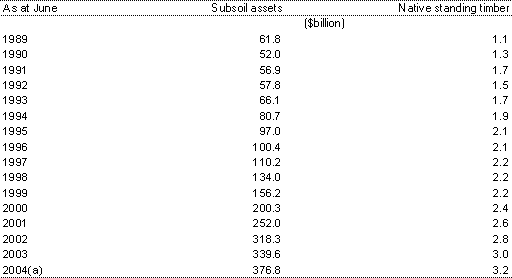
- Preliminary figures.
Source: Australian Bureau of Statistics, 2003-2004, Australian System of National Accounts, cat.no.5204.0, ABS, Canberra.
It is possible to reconcile the main components of the Treasury estimates of wealth at replacement cost with the estimates of produced assets in the ABS balance sheets, although allowance needs to be made for the differences in scope and coverage. While it is not generally possible to derive estimates of wealth at market value from the ABS balance sheets, it is possible to infer an estimate of the valuation ratio (the ratio of the market value of an asset to its replacement cost) for business assets. This is because the net financial assets held by the combined household and unincorporated, general government and foreign sectors (valued at market prices) should represent claims over the net physical assets held by the financial and non-financial corporation sectors (valued at replacement cost). The ratio so derived is reasonably similar to the valuation ratio for business assets which can be derived from the data presented in this article, thus confirming that, apart from the scope and coverage issues noted above, the Treasury wealth estimates are broadly consistent with the ABS estimates in the national balance sheets.
TableA1(a): Nominal private sector wealth at market value
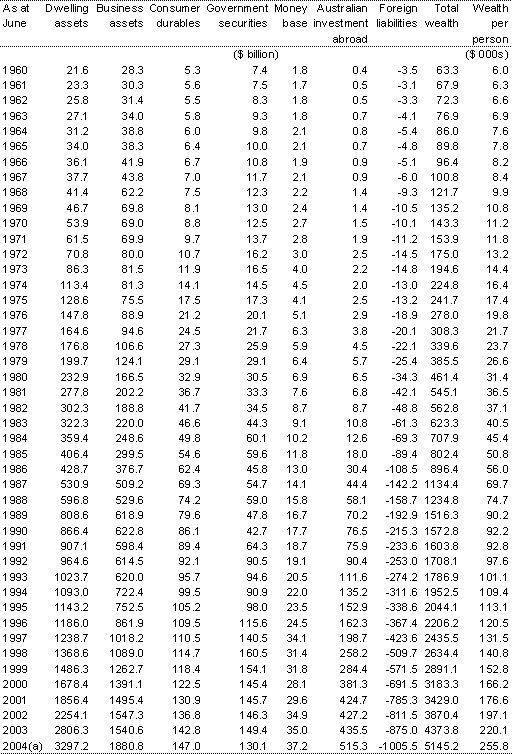
- Preliminary figures.
TableA1(b): Contributions to annual percentage change in nominal private sector wealth at market value

- Preliminary figures.
TableA1(c): Real private sector wealth at market value(a)
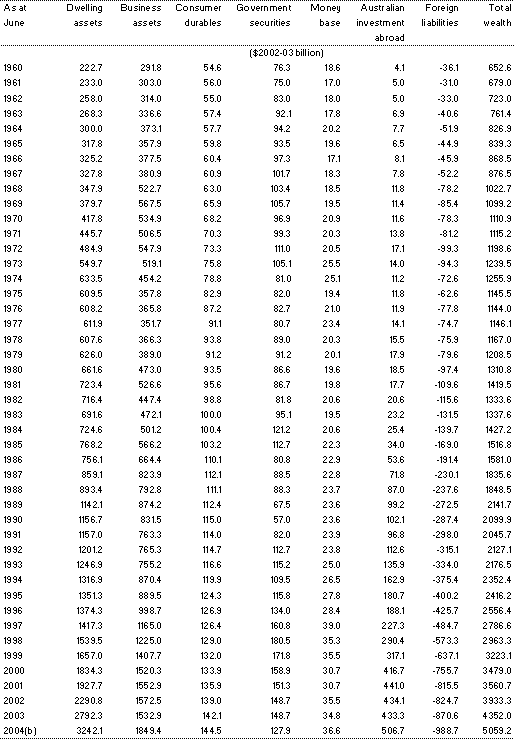
- Real wealth is calculated by dividing nominal wealth by the private consumption deflator.
- Preliminary figures.
Table A1(d): Real private sector wealth per person at market value(a)
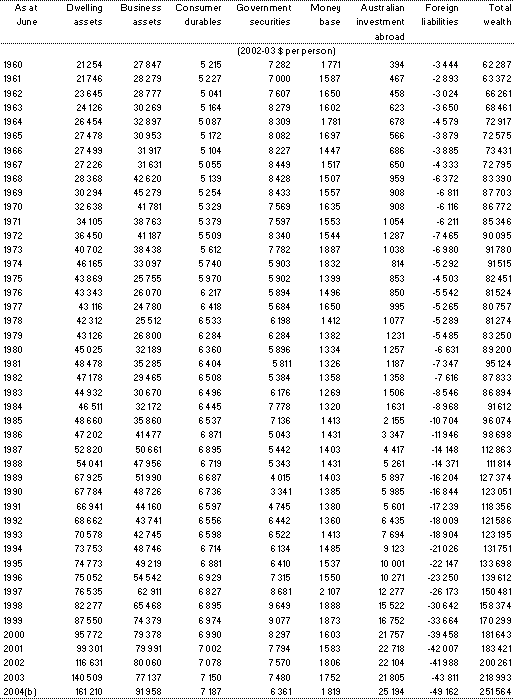
- Real wealth is calculated by dividing nominal wealth by the private consumption deflator.
- Preliminary figures.
TableA2: Nominal private sector wealth at replacement cost
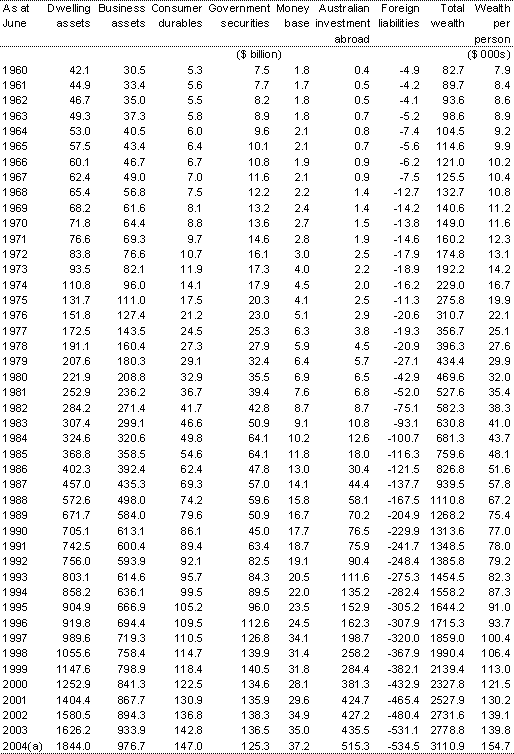
- Preliminary figures.
1 See the article, ‘The Measurement of Saving in Australia’, in the Economic Roundup, Spring 1999.
2 Consolidating the private household and business sectors implies that the bulk of financial instruments held by households (such as bank deposits, debt instruments and superannuation) are netted out in the analysis.
3 Details on assets by sector are available in the ABS publication Australian National Accounts: National Balance Sheet (cat. no. 5241.0), and Bacon (1998) discusses household wealth estimates in detail.
4 Other approaches for constructing estimates of wealth include the portfolio and estate methods. Piggott (1987) provides a useful summary of these approaches.
5 The wealth estimates presented in this article measure wealth owned by Australians, regardless of where that wealth is located. For example, an Australian-owned factory located overseas contributes to Australian net private wealth, while an overseas-owned factory located in Australia does not.
6 Business capital stock includes both rural and non-rural assets.
7 It is assumed that the market valuations of listed and non-listed companies move together.